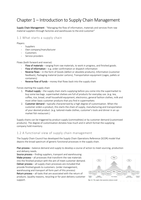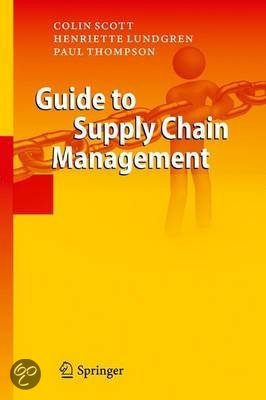Chapter 1 – Introduction to Supply Chain Management
Supply Chain Management - “Managing the flow of information, materials and services from raw
material suppliers through factories and warehouses to the end customer”
1.1 What starts a supply chain
Players:
- Suppliers
- Own company/manufacturer
- Customers
- Service providers
Flows (both forward and reverse):
- Flow of materials – ranging from raw materials, to work in progress, and finished goods.
- Flow of information – e.g. order confirmation or dispatch information
- Reverse flows – in the form of Goods (defect or obsolete products), Information (customer
feedback), Packaging material (outer cartons), Transportation equipment (cages, pallets or
containers)
- Reverse flow of funds – money that flows back into the supply chain
Forces starting the supply chain
1. Product supply – the supply chain starts supplying before you come into the supermarket to
buy some tea bags. supermarket shelves are full of products for everyday use. (e.g. tea,
coffee, rice, bread, small household equipment, electronics, general fashion clothes, milk and
most other basic customer products that you find in supermarkets
2. Customer demand – typically characterised by a high degree of customisation. When the
customer orders a product, this starts the chain of supply, manufacturing and transportation
of your desired product. (e.g. tailored-made clothes, customer’s tools and dinner in an up-
market fish restaurant.)
Supply chains can be triggered by product supply (commodities) or by customer demand (customised
products). The degree of customisation dictates how much and in which format the supplying
company hold inventory.
1.2 A functional view of supply chain management
The Supply Chain Council has developed the Supply Chain Operations Reference (SCOR) model that
depicts the broad spectrum of generic functional processes in the supply chain.
Plan process – balance demand and supply to develop a course of action to meet sourcing, production
and delivery needs.
Source process – finding suppliers, transport and warehousing
Make process – all processes that transform the raw materials
into the finished product with the aim of meet customer demand.
Deliver process – all supply chain processes are included that
provide finished goods to customers. (order management,
warehousing and transport all form part of this process)
Return process – all tasks that are associated with the return of
products. (quality reasons, recycling or for post delivery customer
support.





